Financial Management: Risk, Return, and Share Price Optimization
VerifiedAdded on 2020/03/16
|6
|1308
|48
Essay
AI Summary
This essay delves into the fundamental concepts of financial management, specifically focusing on the interplay between risk and return and their impact on share price valuation. It begins by introducing the core theory of risk assessment, emphasizing the use of anticipated returns and statistical measures. The discussion highlights the importance of understanding the relationship between risk and return for accountants, who must consider these factors when making financial decisions to maximize share value. The essay differentiates between various types of risks, including business risk, financial risk, market risk, and others, and their impact on financial accountants and shareholders. The essay also explores how accountants measure returns, the use of risk aversion strategies, and the role of accounting methods in influencing earnings and their relationship with market-wide earnings. The conclusion emphasizes the accountant's role in assessing risk and return to ensure anticipated returns justify the level of risk being introduced, contributing to rising share prices.
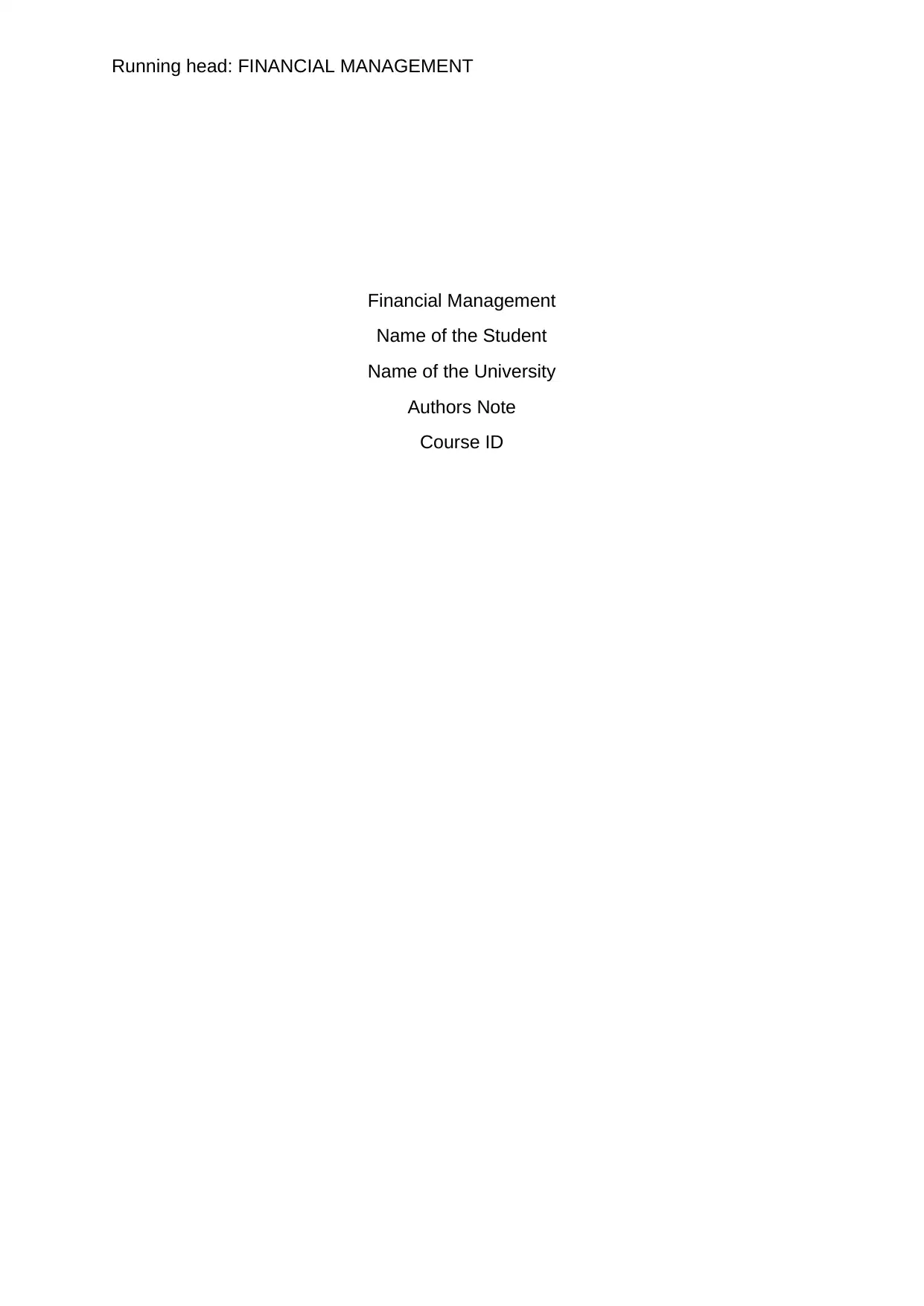
Running head: FINANCIAL MANAGEMENT
Financial Management
Name of the Student
Name of the University
Authors Note
Course ID
Financial Management
Name of the Student
Name of the University
Authors Note
Course ID
Paraphrase This Document
Need a fresh take? Get an instant paraphrase of this document with our AI Paraphraser
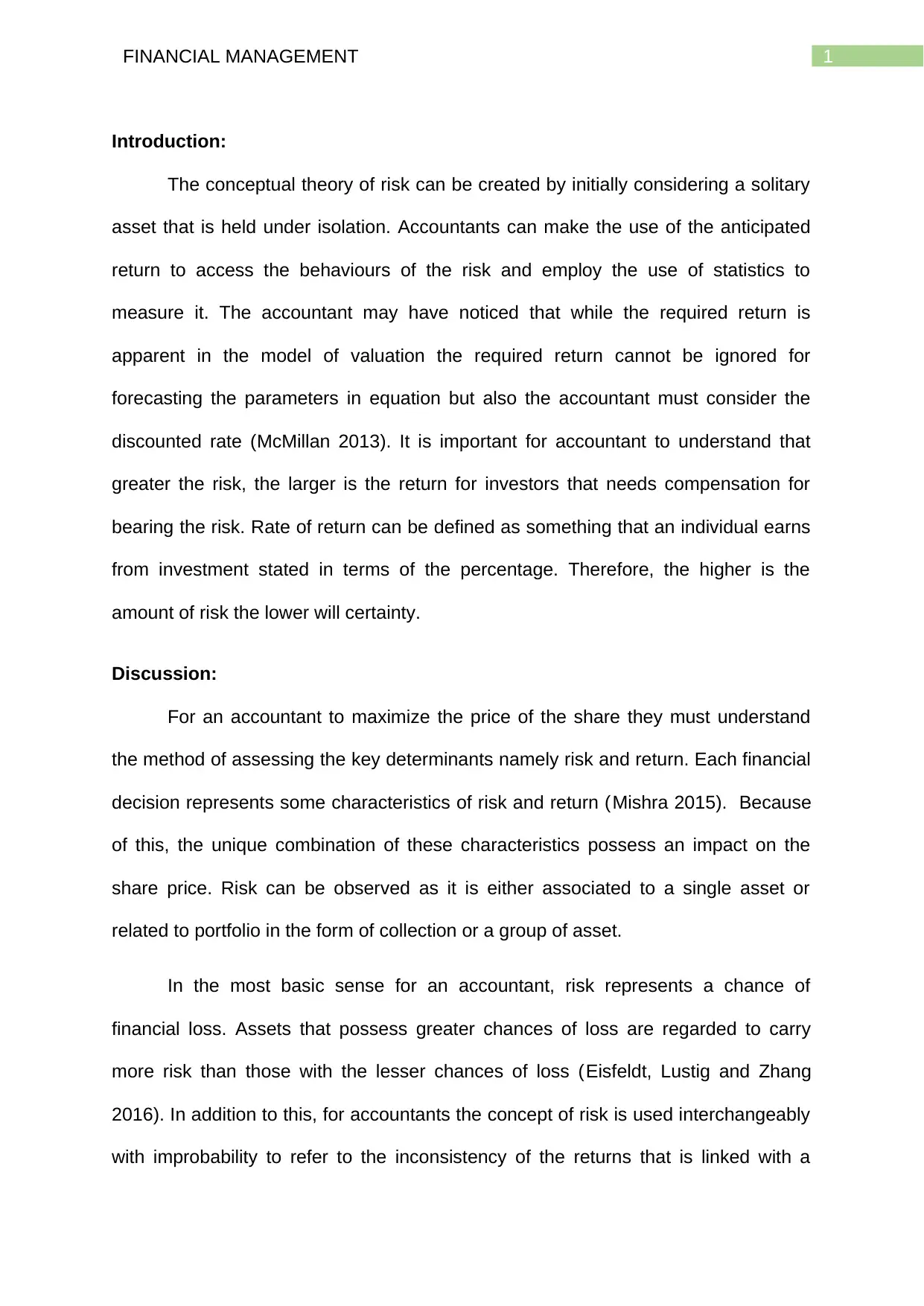
1FINANCIAL MANAGEMENT
Introduction:
The conceptual theory of risk can be created by initially considering a solitary
asset that is held under isolation. Accountants can make the use of the anticipated
return to access the behaviours of the risk and employ the use of statistics to
measure it. The accountant may have noticed that while the required return is
apparent in the model of valuation the required return cannot be ignored for
forecasting the parameters in equation but also the accountant must consider the
discounted rate (McMillan 2013). It is important for accountant to understand that
greater the risk, the larger is the return for investors that needs compensation for
bearing the risk. Rate of return can be defined as something that an individual earns
from investment stated in terms of the percentage. Therefore, the higher is the
amount of risk the lower will certainty.
Discussion:
For an accountant to maximize the price of the share they must understand
the method of assessing the key determinants namely risk and return. Each financial
decision represents some characteristics of risk and return (Mishra 2015). Because
of this, the unique combination of these characteristics possess an impact on the
share price. Risk can be observed as it is either associated to a single asset or
related to portfolio in the form of collection or a group of asset.
In the most basic sense for an accountant, risk represents a chance of
financial loss. Assets that possess greater chances of loss are regarded to carry
more risk than those with the lesser chances of loss (Eisfeldt, Lustig and Zhang
2016). In addition to this, for accountants the concept of risk is used interchangeably
with improbability to refer to the inconsistency of the returns that is linked with a
Introduction:
The conceptual theory of risk can be created by initially considering a solitary
asset that is held under isolation. Accountants can make the use of the anticipated
return to access the behaviours of the risk and employ the use of statistics to
measure it. The accountant may have noticed that while the required return is
apparent in the model of valuation the required return cannot be ignored for
forecasting the parameters in equation but also the accountant must consider the
discounted rate (McMillan 2013). It is important for accountant to understand that
greater the risk, the larger is the return for investors that needs compensation for
bearing the risk. Rate of return can be defined as something that an individual earns
from investment stated in terms of the percentage. Therefore, the higher is the
amount of risk the lower will certainty.
Discussion:
For an accountant to maximize the price of the share they must understand
the method of assessing the key determinants namely risk and return. Each financial
decision represents some characteristics of risk and return (Mishra 2015). Because
of this, the unique combination of these characteristics possess an impact on the
share price. Risk can be observed as it is either associated to a single asset or
related to portfolio in the form of collection or a group of asset.
In the most basic sense for an accountant, risk represents a chance of
financial loss. Assets that possess greater chances of loss are regarded to carry
more risk than those with the lesser chances of loss (Eisfeldt, Lustig and Zhang
2016). In addition to this, for accountants the concept of risk is used interchangeably
with improbability to refer to the inconsistency of the returns that is linked with a
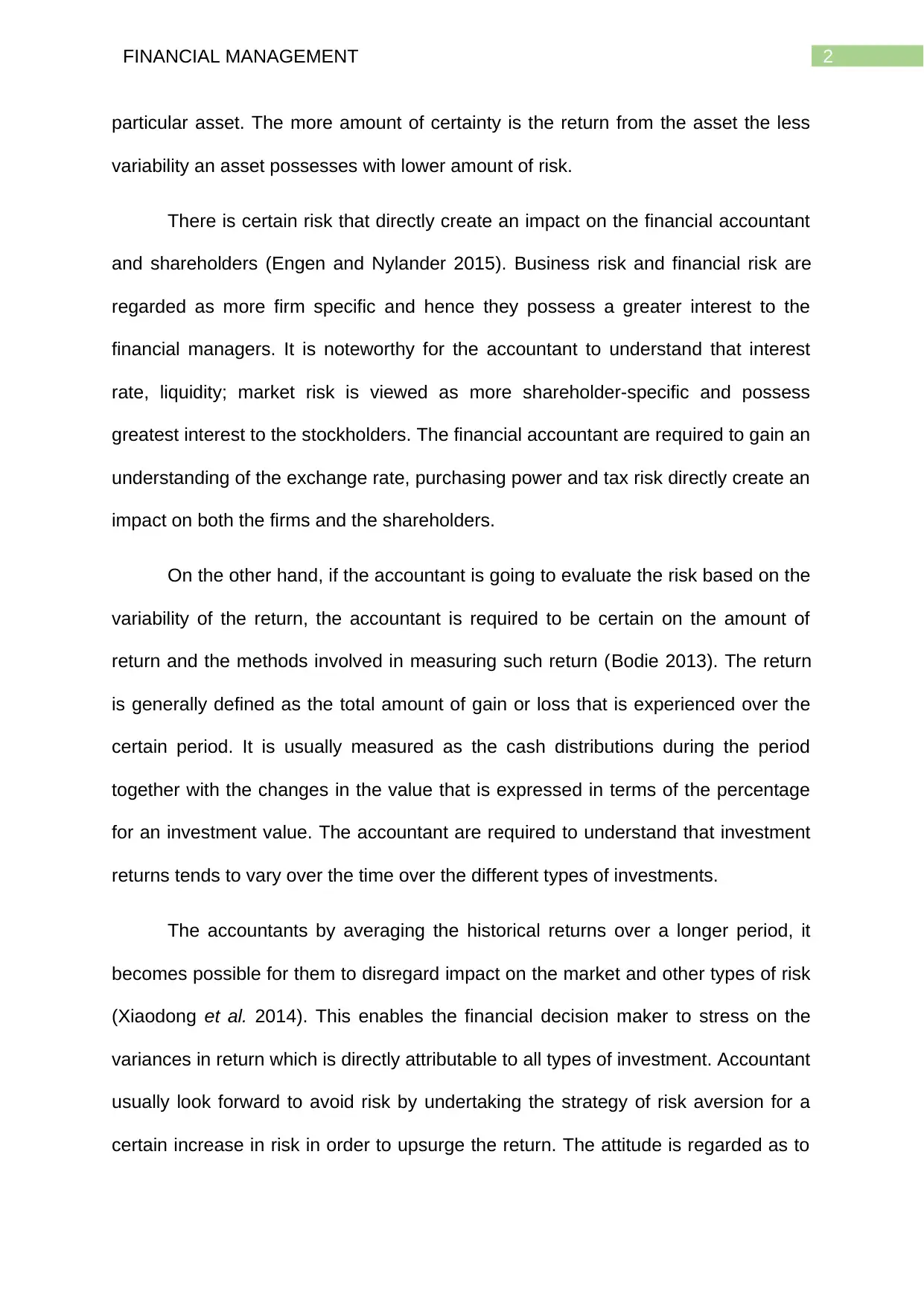
2FINANCIAL MANAGEMENT
particular asset. The more amount of certainty is the return from the asset the less
variability an asset possesses with lower amount of risk.
There is certain risk that directly create an impact on the financial accountant
and shareholders (Engen and Nylander 2015). Business risk and financial risk are
regarded as more firm specific and hence they possess a greater interest to the
financial managers. It is noteworthy for the accountant to understand that interest
rate, liquidity; market risk is viewed as more shareholder-specific and possess
greatest interest to the stockholders. The financial accountant are required to gain an
understanding of the exchange rate, purchasing power and tax risk directly create an
impact on both the firms and the shareholders.
On the other hand, if the accountant is going to evaluate the risk based on the
variability of the return, the accountant is required to be certain on the amount of
return and the methods involved in measuring such return (Bodie 2013). The return
is generally defined as the total amount of gain or loss that is experienced over the
certain period. It is usually measured as the cash distributions during the period
together with the changes in the value that is expressed in terms of the percentage
for an investment value. The accountant are required to understand that investment
returns tends to vary over the time over the different types of investments.
The accountants by averaging the historical returns over a longer period, it
becomes possible for them to disregard impact on the market and other types of risk
(Xiaodong et al. 2014). This enables the financial decision maker to stress on the
variances in return which is directly attributable to all types of investment. Accountant
usually look forward to avoid risk by undertaking the strategy of risk aversion for a
certain increase in risk in order to upsurge the return. The attitude is regarded as to
particular asset. The more amount of certainty is the return from the asset the less
variability an asset possesses with lower amount of risk.
There is certain risk that directly create an impact on the financial accountant
and shareholders (Engen and Nylander 2015). Business risk and financial risk are
regarded as more firm specific and hence they possess a greater interest to the
financial managers. It is noteworthy for the accountant to understand that interest
rate, liquidity; market risk is viewed as more shareholder-specific and possess
greatest interest to the stockholders. The financial accountant are required to gain an
understanding of the exchange rate, purchasing power and tax risk directly create an
impact on both the firms and the shareholders.
On the other hand, if the accountant is going to evaluate the risk based on the
variability of the return, the accountant is required to be certain on the amount of
return and the methods involved in measuring such return (Bodie 2013). The return
is generally defined as the total amount of gain or loss that is experienced over the
certain period. It is usually measured as the cash distributions during the period
together with the changes in the value that is expressed in terms of the percentage
for an investment value. The accountant are required to understand that investment
returns tends to vary over the time over the different types of investments.
The accountants by averaging the historical returns over a longer period, it
becomes possible for them to disregard impact on the market and other types of risk
(Xiaodong et al. 2014). This enables the financial decision maker to stress on the
variances in return which is directly attributable to all types of investment. Accountant
usually look forward to avoid risk by undertaking the strategy of risk aversion for a
certain increase in risk in order to upsurge the return. The attitude is regarded as to
⊘ This is a preview!⊘
Do you want full access?
Subscribe today to unlock all pages.

Trusted by 1+ million students worldwide
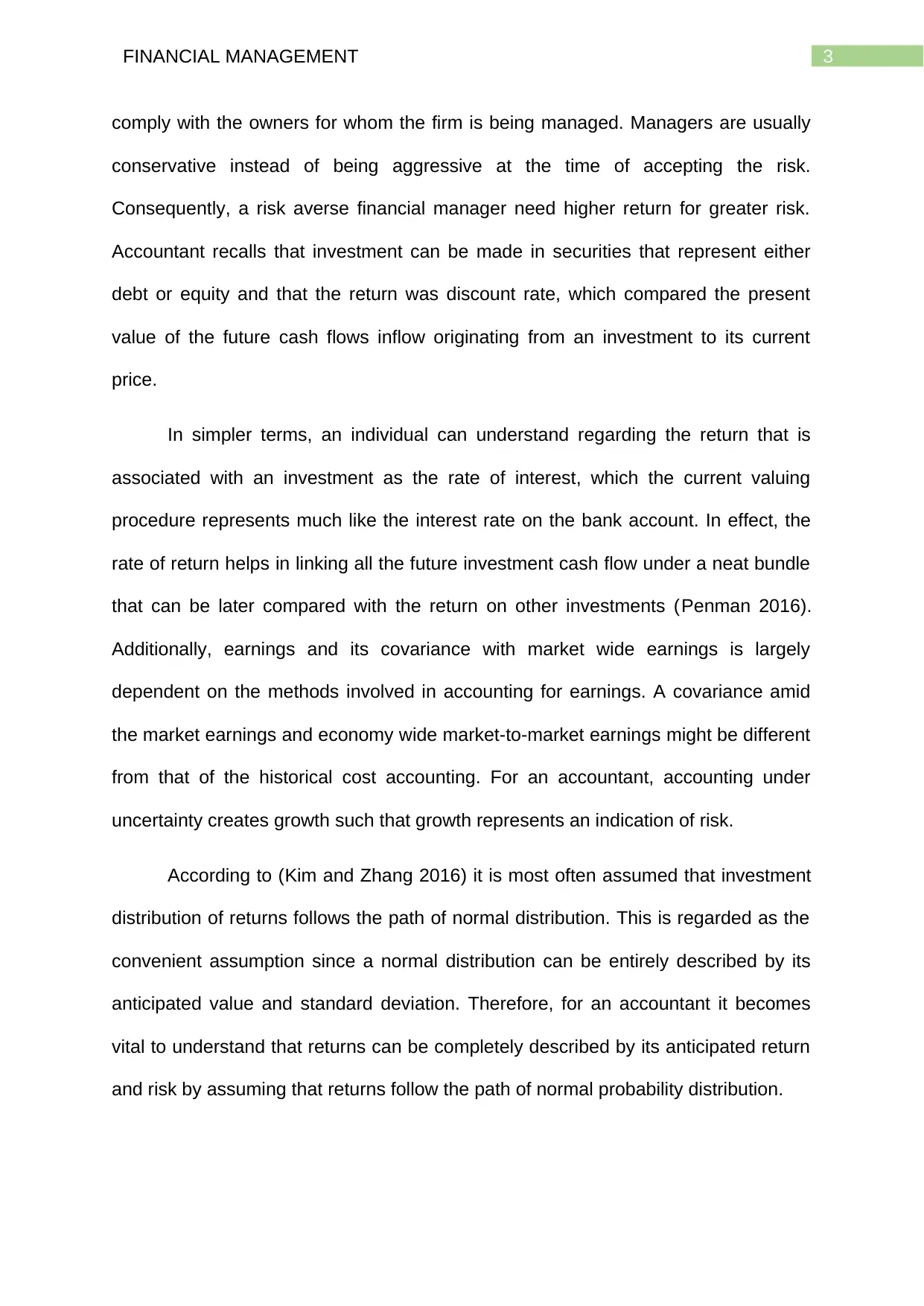
3FINANCIAL MANAGEMENT
comply with the owners for whom the firm is being managed. Managers are usually
conservative instead of being aggressive at the time of accepting the risk.
Consequently, a risk averse financial manager need higher return for greater risk.
Accountant recalls that investment can be made in securities that represent either
debt or equity and that the return was discount rate, which compared the present
value of the future cash flows inflow originating from an investment to its current
price.
In simpler terms, an individual can understand regarding the return that is
associated with an investment as the rate of interest, which the current valuing
procedure represents much like the interest rate on the bank account. In effect, the
rate of return helps in linking all the future investment cash flow under a neat bundle
that can be later compared with the return on other investments (Penman 2016).
Additionally, earnings and its covariance with market wide earnings is largely
dependent on the methods involved in accounting for earnings. A covariance amid
the market earnings and economy wide market-to-market earnings might be different
from that of the historical cost accounting. For an accountant, accounting under
uncertainty creates growth such that growth represents an indication of risk.
According to (Kim and Zhang 2016) it is most often assumed that investment
distribution of returns follows the path of normal distribution. This is regarded as the
convenient assumption since a normal distribution can be entirely described by its
anticipated value and standard deviation. Therefore, for an accountant it becomes
vital to understand that returns can be completely described by its anticipated return
and risk by assuming that returns follow the path of normal probability distribution.
comply with the owners for whom the firm is being managed. Managers are usually
conservative instead of being aggressive at the time of accepting the risk.
Consequently, a risk averse financial manager need higher return for greater risk.
Accountant recalls that investment can be made in securities that represent either
debt or equity and that the return was discount rate, which compared the present
value of the future cash flows inflow originating from an investment to its current
price.
In simpler terms, an individual can understand regarding the return that is
associated with an investment as the rate of interest, which the current valuing
procedure represents much like the interest rate on the bank account. In effect, the
rate of return helps in linking all the future investment cash flow under a neat bundle
that can be later compared with the return on other investments (Penman 2016).
Additionally, earnings and its covariance with market wide earnings is largely
dependent on the methods involved in accounting for earnings. A covariance amid
the market earnings and economy wide market-to-market earnings might be different
from that of the historical cost accounting. For an accountant, accounting under
uncertainty creates growth such that growth represents an indication of risk.
According to (Kim and Zhang 2016) it is most often assumed that investment
distribution of returns follows the path of normal distribution. This is regarded as the
convenient assumption since a normal distribution can be entirely described by its
anticipated value and standard deviation. Therefore, for an accountant it becomes
vital to understand that returns can be completely described by its anticipated return
and risk by assuming that returns follow the path of normal probability distribution.
Paraphrase This Document
Need a fresh take? Get an instant paraphrase of this document with our AI Paraphraser
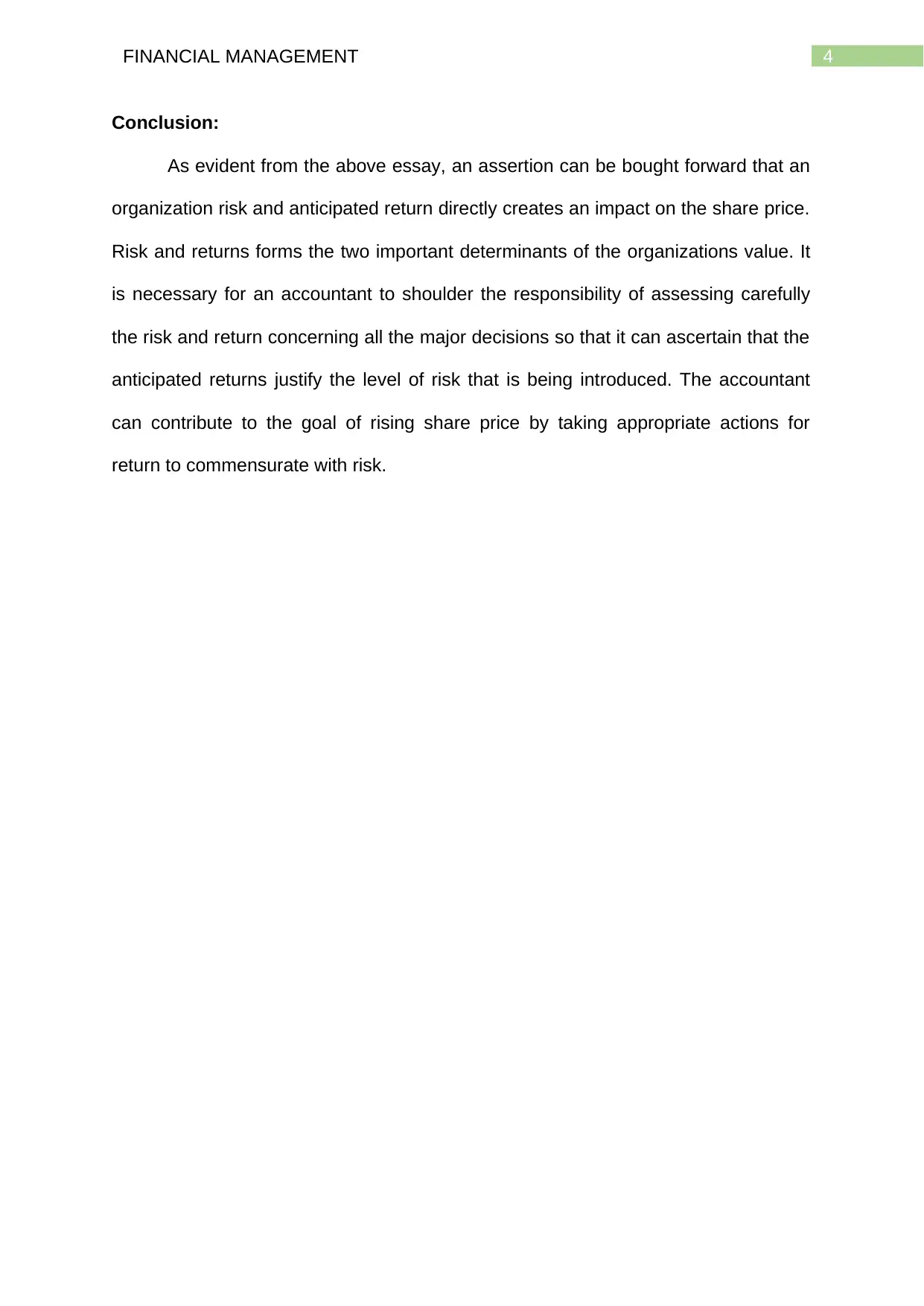
4FINANCIAL MANAGEMENT
Conclusion:
As evident from the above essay, an assertion can be bought forward that an
organization risk and anticipated return directly creates an impact on the share price.
Risk and returns forms the two important determinants of the organizations value. It
is necessary for an accountant to shoulder the responsibility of assessing carefully
the risk and return concerning all the major decisions so that it can ascertain that the
anticipated returns justify the level of risk that is being introduced. The accountant
can contribute to the goal of rising share price by taking appropriate actions for
return to commensurate with risk.
Conclusion:
As evident from the above essay, an assertion can be bought forward that an
organization risk and anticipated return directly creates an impact on the share price.
Risk and returns forms the two important determinants of the organizations value. It
is necessary for an accountant to shoulder the responsibility of assessing carefully
the risk and return concerning all the major decisions so that it can ascertain that the
anticipated returns justify the level of risk that is being introduced. The accountant
can contribute to the goal of rising share price by taking appropriate actions for
return to commensurate with risk.
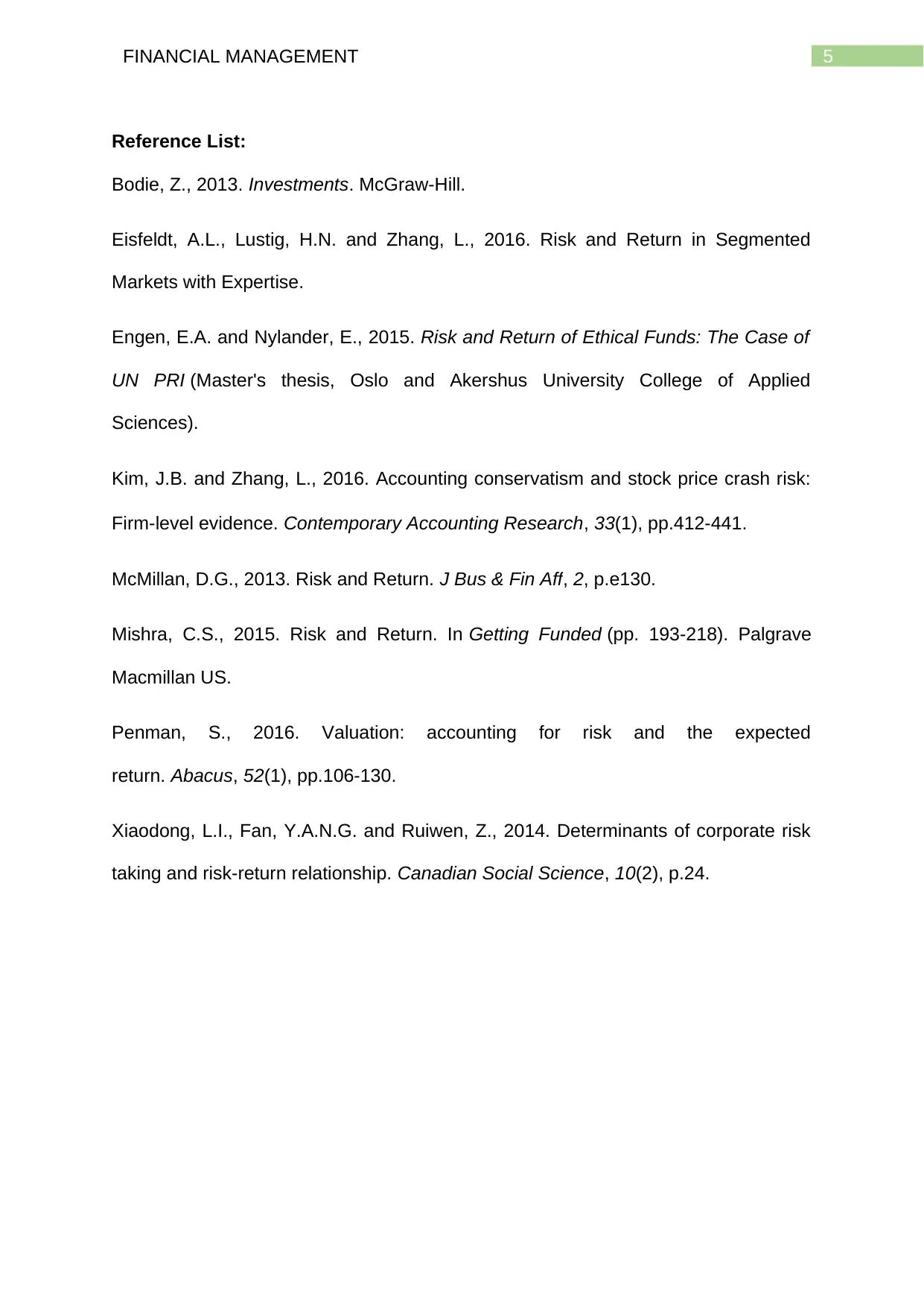
5FINANCIAL MANAGEMENT
Reference List:
Bodie, Z., 2013. Investments. McGraw-Hill.
Eisfeldt, A.L., Lustig, H.N. and Zhang, L., 2016. Risk and Return in Segmented
Markets with Expertise.
Engen, E.A. and Nylander, E., 2015. Risk and Return of Ethical Funds: The Case of
UN PRI (Master's thesis, Oslo and Akershus University College of Applied
Sciences).
Kim, J.B. and Zhang, L., 2016. Accounting conservatism and stock price crash risk:
Firm‐level evidence. Contemporary Accounting Research, 33(1), pp.412-441.
McMillan, D.G., 2013. Risk and Return. J Bus & Fin Aff, 2, p.e130.
Mishra, C.S., 2015. Risk and Return. In Getting Funded (pp. 193-218). Palgrave
Macmillan US.
Penman, S., 2016. Valuation: accounting for risk and the expected
return. Abacus, 52(1), pp.106-130.
Xiaodong, L.I., Fan, Y.A.N.G. and Ruiwen, Z., 2014. Determinants of corporate risk
taking and risk-return relationship. Canadian Social Science, 10(2), p.24.
Reference List:
Bodie, Z., 2013. Investments. McGraw-Hill.
Eisfeldt, A.L., Lustig, H.N. and Zhang, L., 2016. Risk and Return in Segmented
Markets with Expertise.
Engen, E.A. and Nylander, E., 2015. Risk and Return of Ethical Funds: The Case of
UN PRI (Master's thesis, Oslo and Akershus University College of Applied
Sciences).
Kim, J.B. and Zhang, L., 2016. Accounting conservatism and stock price crash risk:
Firm‐level evidence. Contemporary Accounting Research, 33(1), pp.412-441.
McMillan, D.G., 2013. Risk and Return. J Bus & Fin Aff, 2, p.e130.
Mishra, C.S., 2015. Risk and Return. In Getting Funded (pp. 193-218). Palgrave
Macmillan US.
Penman, S., 2016. Valuation: accounting for risk and the expected
return. Abacus, 52(1), pp.106-130.
Xiaodong, L.I., Fan, Y.A.N.G. and Ruiwen, Z., 2014. Determinants of corporate risk
taking and risk-return relationship. Canadian Social Science, 10(2), p.24.
⊘ This is a preview!⊘
Do you want full access?
Subscribe today to unlock all pages.

Trusted by 1+ million students worldwide
1 out of 6
Related Documents
Your All-in-One AI-Powered Toolkit for Academic Success.
+13062052269
info@desklib.com
Available 24*7 on WhatsApp / Email
![[object Object]](/_next/static/media/star-bottom.7253800d.svg)
Unlock your academic potential
Copyright © 2020–2025 A2Z Services. All Rights Reserved. Developed and managed by ZUCOL.




